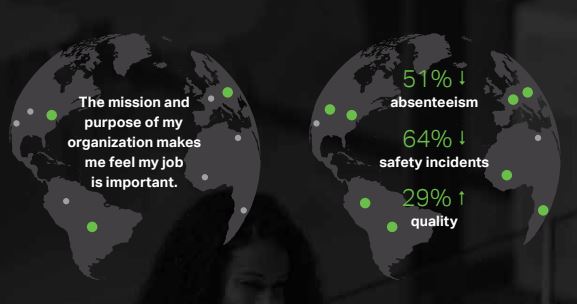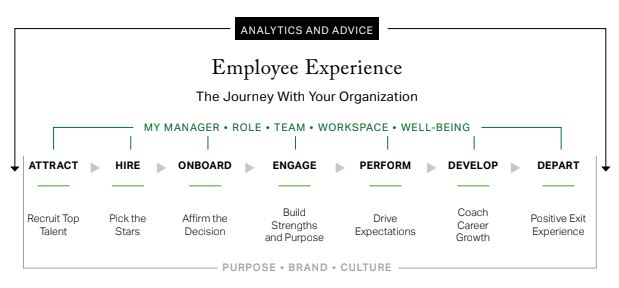COPYRIGHT STANDARDS
This document contains proprietary research, copyrighted and trademarked materials of Gallup, Inc. Accordingly, international and domestic laws and penalties guaranteeing patent, copyright, trademark and trade secret protection safeguard the ideas, concepts and recommendations related within this document. The materials contained in this document and/or the document itself may be downloaded and/or copied provided that all copies retain the copyright, trademark and any other proprietary notices contained on the materials and/or document. No changes may be made to this document without the express written permission of Gallup, Inc.
Any reference whatsoever to this document, in whole or in part, on any web page must provide a link back to the original document in its entirety. Except as expressly provided herein, the transmission of this material shall not be construed to grant a license of any type under any patents, copyright or trademarks owned or controlled by Gallup, Inc. The Gallup Q12 items are Gallup proprietary information and are protected by law. You may not administer a survey with the Q12 items and/or reproduce them without written consent from Gallup, Inc. The Gallup Q12 items are protected by copyright of Gallup, Inc., 1993-1998, 2018. All rights reserved. Gallup® and Q12® are trademarks of Gallup, Inc. All rights reserved. All other trademarks and copyrights are property of their respective owners.
Executive Insights
The employee experience is the journey an employee takes with your organization. It includes all the interactions an employee has with your organization before, during and after their tenure.
The employee life cycle defines the critical stages that employers must get right — the components that HR strategy will have the most influence on during the employee experience.
These interactions shape employees’ perceptions of your organization and directly affect employee performance and your brand as an employer.
Employee engagement, performance and development are key themes throughout most of the employee life cycle. Getting them right is essential to getting employee experience right.
Employees have become “consumers of the workplace.” A new generation of worker expectations, greater workplace transparency and a tightening labor market have increased interest in improving the employee experience.
Purpose, brand and culture are foundations that determine how you customize elements of the employee life cycle and employee experience to represent your organization’s unique identity.
What Is the Employee Experience?
The employee experience is the journey an employee takes with your organization. It is the sum of all interactions an employee has with an employer, from prerecruitment to post-exit. It includes everything from major milestones and personal relationships to technology use and the physical work environment.
All of the individual moments of an employee’s experience play a role in how a worker feels about an employer’s purpose, brand and culture. These feelings directly affect employee retention, engagement, performance and development.

One-third of global employees strongly agree with the statement, “The mission and purpose of my organization makes me feel my job is important.” By moving that ratio to eight in 10 employees, business units have realized a 51% reduction in absenteeism, a 64% drop in safety incidents and a 29% improvement in quality.
The employee experience can also influence an employee’s decision to return to a former employer and their likelihood to recommend an organization to other high-talent individuals. As a result, optimizing the employee experience has become a strategic priority for many HR leaders today.
Employee Experience and the Competition for Talent
Today’s employee is a consumer of the workplace. Employees are no longer satisfied with clocking in and out and receiving a paycheck. They are looking for meaning in their work, a supportive, collaborative environment, and an employer that can match the lifestyle they want to enjoy.
According to our recent State of the American Workplace report, the majority of employees say a role that allows them to have greater work-life balance and better personal well-being is “very important” to them. And, 91% of employees say the last time they changed jobs, they left their company to do so. What’s more, employees can afford to be choosy, as a result of a tightening labor market and increasing competition for high-talent performers. Currently, 63% of employees believe it is “very likely” or “somewhat likely” that they could find a job as good as the one they
have.
And 51% of currently employed workers say they are actively looking for a new job or watching for openings. It is not surprising, then, that employers are beginning to think of employees more like customers. Many organizations are realizing that they must pay closer attention to the
moments that matter most when employees decide to join or remain with an organization.
The influence of social media also plays a role. Workplace moments can quickly go viral, even within an employer’s internal communication tools like Slack, an online communication and collaboration hub for workplaces. Tools like this provide a great opportunity to promote an organization’s brand in an authentic way.
They also can cause headaches when leaders must deal with incomplete perceptions about their workplace or with negative reviews on websites like Glassdoor. No doubt the stakes for employers are higher than ever when it comes to reputation, culture and talent. Employers are beginning to ask deeper, tougher questions about what makes a great employee experience.
63%
of employees believe it is “very likely” or
“somewhat likely” that they could find a job
as good as the one they have.
Developing a Comprehensive Employee Experience Strategy
Where should an organization begin when developing a new employee experience approach? What matters most? What changes are proven to create real value for an organization? The following are three key phases that every organization should consider when developing an employee experience strategy:
• Align your employee experience to purpose, brand and culture.
• Focus on the seven essential stages of the employee life cycle.
• Remember the core needs at the heart of every stage.
Align Your Employee Experience to Purpose, Brand and Culture
The employee life cycle and the experiences within them should be uniquely built to reflect your organization’s distinctive purpose, brand and culture. For example, if your organization promotes a customer-centric culture, how is that culture experienced by employees in your hiring and onboarding processes? Where does it show up on performance reviews? How might it be expressed in the way you say “goodbye” to employees who are moving on or retiring?
Rituals play an important role in defining an organization’s culture. The experience of a new hire, a performance review or a firing not only influence the individual, but they also express “who we are” and “what we care about” to the rest of the team. Employees are often spectators of or participants in the full life cycle of their peers. Watching a friend receive public recognition may reinforce a culture as much as personally receiving recognition.
Employee experience should begin with a clear understanding of your organization’s brand, purpose and the culture you want to create. If you want to have a unique and powerful employee experience, every part of the employee life cycle should be implemented according to your distinctive organizational identity.
Focus on the Seven Essential Stages of the Employee Life Cycle
The employee life cycle identifies the seven major stages that employers need to get right within the employee experience. These landmark elements contain both key milestones, such as attraction, onboarding and exit, and also continual demands, such as providing an engaging workplace, managing performance and developing employees. They capture the most significant employee-employer interactions that shape employee perceptions. For organizations that are just beginning to think about employee experience, examining the seven strategies in the context of your culture is a good place to start.

The following are the kinds of questions organizations might ask when looking at their current HR processes through an employee experience lens:
Attract: What elements of our culture are we highlighting to attract top talent?
Hire: Does our hiring process feel fair? Does our process pick stars?
Onboard: Do we affirm the decision employees made to join us? Do new hires experience our values?
Engage: Do our employees show up every day enthusiastic and involved in their work? Do we build on strengths and purpose?
Perform: Do performance reviews seem fair and accurate? Are we driving expectations to higher levels?
Develop: Do our top performers see a future with us? Do we offer flexible, personalized career paths? Do we continually coach career growth?
Depart: Who are our talent competitors? Why does our best talent leave? Do we create a positive exit experience?
The employee experience journey has to be well-thought-out and activated within each of the employee life cycle stages. Much like a consumer experience, one negative experience in the process can create problems throughout the system. Employee experience thinking takes all of these elements into consideration when forming a talent strategy. Other key factors for employee experience include the individual’s manager, role, team, workspace and workplace, and well-being.
Remember the Core Needs at the Heart of Every Stage
A few constants in your workplace have a significant influence on the quality of the employee experience at each stage of the employee life cycle: the quality of the relationship that an employee has with their manager, the clarity of their role, the value they bring to their team, the space and place where they work, and how their work affects their overall well-being.
Manager: The manager-employee relationship is the most important relationship at every stage of the employee journey. Managers affect employees’ work experience in how they engage them and develop their strengths. Managers are in a position to continually help the employee see their current value and future in the organization. That means any employee experience strategy must prioritize the identification and development of great managers.
Role: “What is expected of me?” is a simple question, but it often goes unanswered in the workplace. Less than half (41%) of U.S. workers strongly agree that their job description aligns well with the work they are asked to do. Each employee’s role and clarity of job responsibilities are initially defined during role orientation. But the role is redefined ongoing through involvement in goal setting, meaningful feedback and semiannual reviews.
Team: People perform at their best when they respect the people they are working with and trust that they are going to perform at their best. They also need to see how they are a valued member of their team. Employees need to know who their trusted partners are during onboarding, and then their partners continue to evolve as the employees learn who they can win with throughout their tenure.
Workspace: An appropriate physical environment is a psychological necessity for getting work done. A supportive work environment should give employees the freedom to work in the ways they feel are best — for example, with spaces to collaborate or work privately, depending on the task at hand. Light, temperature, ergonomics, noise and distractions are other factors in the employee experience.
Well-being: It’s difficult to imagine a great employee experience without frequent “good days.” Gallup’s global research has found that what makes a good day (and a good life) is surprisingly universal. It includes factors such as having a life full of love, having the energy to do what you want to do and giving back to one’s community. Gallup identifies five elements of well-being: purpose, social, financial, physical and community.
Employee Experience and Employee Engagement
The employee experience is not a replacement for employee engagement. Well-designed employee engagement systems include critical and continual experiences that drive performance and improve culture by addressing role clarity, meaningful feedback, belonging, learning and progress. Employee engagement involves the basic psychological needs that must be met for employees to perform their specific role well. An engaged employee “shows up,” physically, emotionally and cognitively. They are enthusiastic about what they have to do, and they naturally find ways to improve and excel. In short, engaged employees generate most of the creativity, innovation and excellence in your organization.

The primary questions that employees need answered to work productively include:
Do I know what is expected of me?
Do I have the materials and equipment I need to do my work right?
Do I get to do what I do best every day?
Have I received recognition for my work recently?
Does my supervisor care about me as a person?
Does someone at work encourage my development?
Do my opinions count?
Does the mission of my organization make me feel my job is important?
Is my team committed to doing quality work?
Do I have a best friend at work?
Has someone talked to me recently about my progress?
Do I have opportunities to learn and grow?
Unfortunately, far too many employees do not have these basic needs met. For example, globally only one in three employees strongly agree that they have the materials and equipment they need to do their work right or that they have the opportunity to do what they do best every day. In the employee life cycle, engagement is at the center, not only literally as the fourth of seven stages but also theoretically, as most stages of the employee life cycle play some role in engagement — for example, knowing how your role fits into your company’s mission should be part of any onboarding process. However, engagement involves the daily execution of one’s role, and increasing employee engagement is primarily the responsibility of managers.
Gallup’s analysis shows that the manager alone accounts for 70% of the variance in team engagement. In the life cycle, engagement appears before performance because engagement is foundational to high performance and ongoing development. With engagement, high performance is easy to coach. Without engagement, high performance is unlikely. Performance appears before development because the best form of development happens as employees are experiencing their work with great coaching — involvement in setting goals and receiving meaningful feedback. When employees have their basic psychological needs met, they can focus on mastering their tasks and producing exceptional outcomes.
Engagement, performance and development are the three stages that capture most of the day-to-day experiences of employees. They are also the responsibility of managers: engaging the team, coaching for high performance, and shaping personalized, long-term growth. For this reason, the
hiring, training and developing of great managers should be at the core of any employee experience strategy. A manager’s own employee experience is central to building a culture of high engagement — and manager engagement and well-being are often in no better shape than those of the employees they manage.
The manager alone accounts for 70% of the variance in team engagement based on:
• the manager’s innate tendencies
• the manager’s engagement
• the employee’s perception of the manager’s behaviors
The Employee Journey: Building an Exceptional Employee Experience
The employee journey is a detailed description of an employee’s path through the employee life cycle, from a first-person point of view. What does it feel like to be recruited? Hired? Managed? What does it feel like when you leave the organization? Imagining and measuring these experiences can help leaders better see the human element of the workplace.
ATTRACT: RECRUIT TOP TALENT
While overall compensation is still extremely important to nearly half of younger employees, it falls below opportunities to learn and
advance, quality of their manager, and having interesting work. Companies spend a lot of time and money marketing to loyal customers, but they often neglect developing an equally strong focus on employment brand. Today’s workplace is highly transparent. Internal employee experiences can quickly shape external perceptions of what your organization stands for. High-talent individuals are particularly interested in working for organizations that have strong purpose and values — and that live them out authentically.
ENGAGE: BUILD STRENGTHS AND PURPOSE
Only 15% of employees, globally, and 33% in the U.S. are engaged. Engagement is about much more than making sure employees are satisfied with where they work. Gallup research finds that workplace perks matter less than the relationship between a manager and an employee. Employees today are looking for a coach who cares about them, keeps them accountable and focuses on future excellence and career growth.
PERFORM: DRIVE EXPECTATIONS
Just two in 10 employees strongly agree that their performance is managed in a way that motivates them to do outstanding work. Many organizations are realizing that delivering an annual performance review is not enough to improve employee performance. In fact, it often backfires, decreasing performance instead. Employees respond best to regular informal feedback on their work and frequent praise and recognition for excellent work. An employee also needs to feel that their performance — reflecting their individual achievement, team collaboration and customer value — is reviewed in a fair and comprehensive way.
DEVELOP: COACH CAREER GROWTH
The No. 1 reason people change jobs today is “career growth opportunities.”
For many of today’s workers, the “corporate ladder” is broken. Changes to job titles and pay raises are often too infrequent to satisfy the universal human desire to grow and develop. Employees need to see a path forward in your organization: opportunities to gain new skills, work with new people or enjoy greater autonomy. These opportunities happen most optimally through ongoing coaching conversations. Engaged employees report having meaningful feedback at least once per week. Ongoing conversations can take the form of quick 10- to 30-minute connections, deeper
developmental feedback or semiannual progress reviews.
DEPART: POSITIVE EXIT EXPERIENCE
According to SHRM’s recent human capital benchmarking report, the average annual organizational turnover rate in the U.S. in 2016 was 18%. An employee exit can be the most emotional and uncertain phase of an employee’s journey. At its best, exiting is the final stage of an ongoing coaching conversation about the employee’s experience, performance, development and perceptions of the organization. Regardless of the terms, employees have a need to feel heard and to be appreciated for their contributions. An excellent exit program generates proud “alumni” and brand ambassadors that can pay long-term dividends for your talent strategy.
World-class employee experiences attract top talent through a strong brand reputation, drive high performance through meaningful manager-employee relationships and create valuable brand ambassadors long after employees have left your organization. World-class employee experiences can also lead to employees who choose to spend their career with your organization — because your organization provides them the best opportunity to
develop and continually improve their well-being.
Gallup’s Expertise in Your Boardroom
Gallup knows more about today’s employees than anyone else in the world.
Gallup can help you design your employee experience and employee life cycle, from attraction strategy to exit surveys. We help leaders answer their most pressing questions:
Gallup combines decades of global research with today’s latest data science to provide advice and analytics to the world’s leading organizations, governments, universities and corporations.

